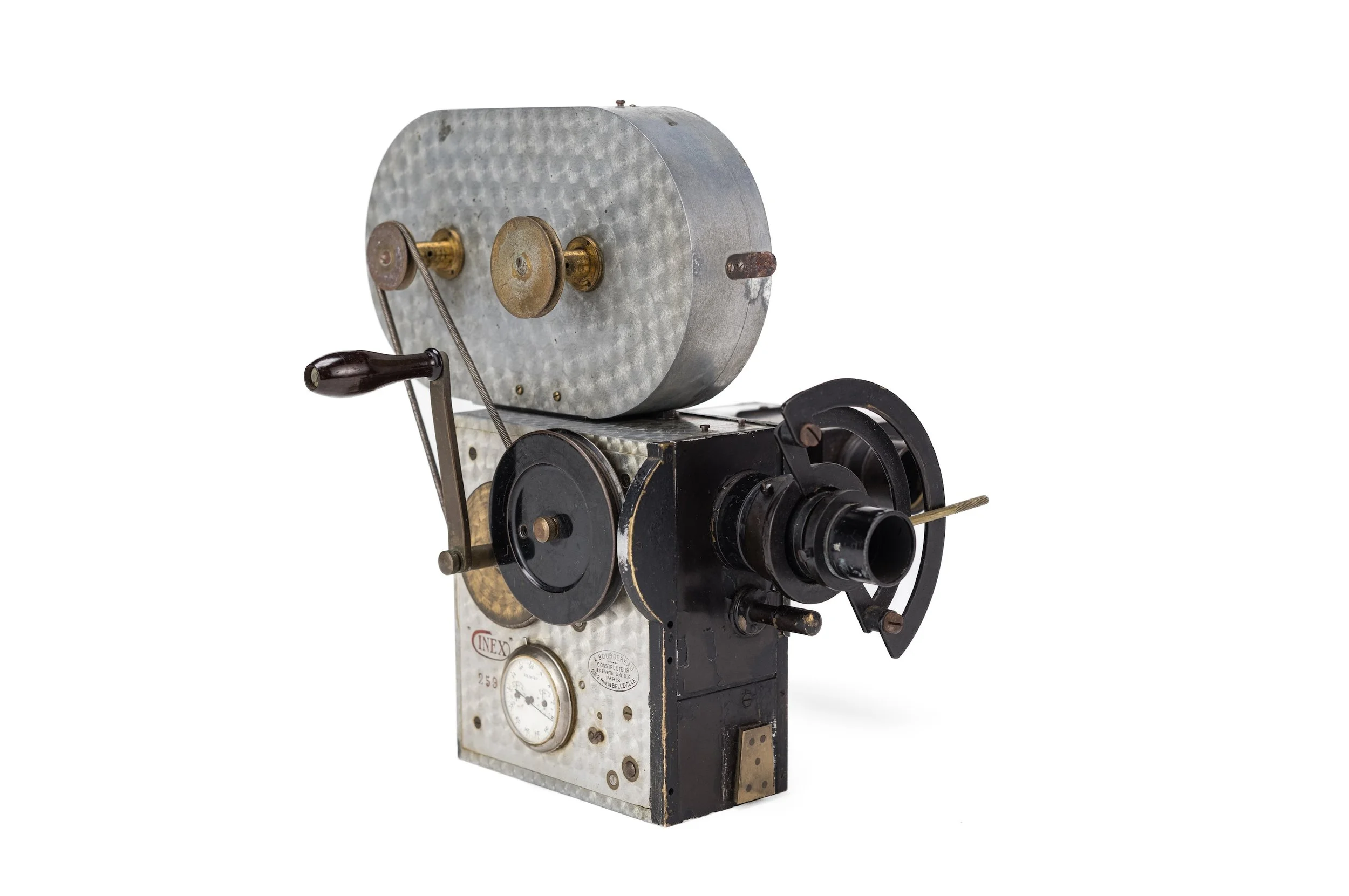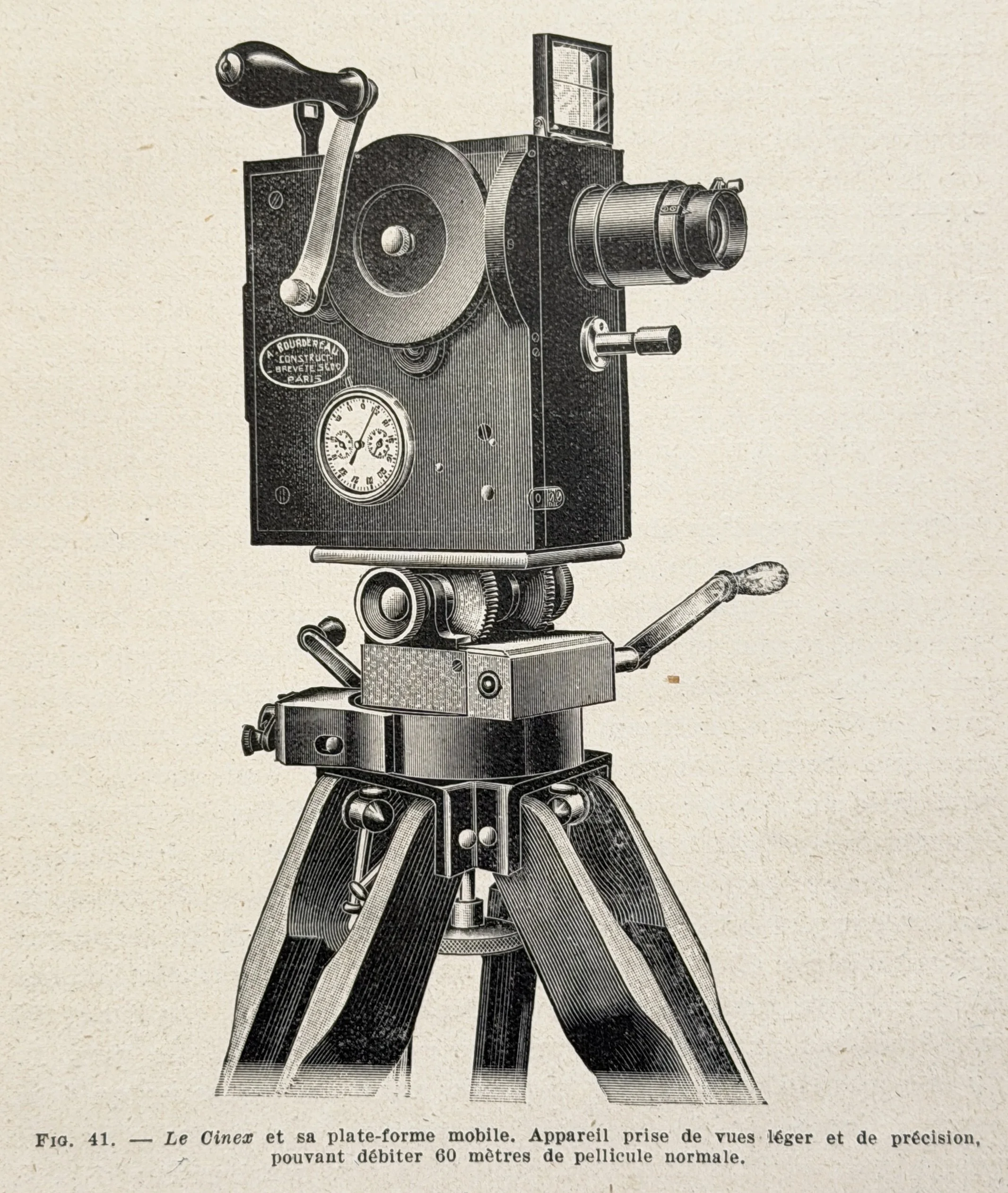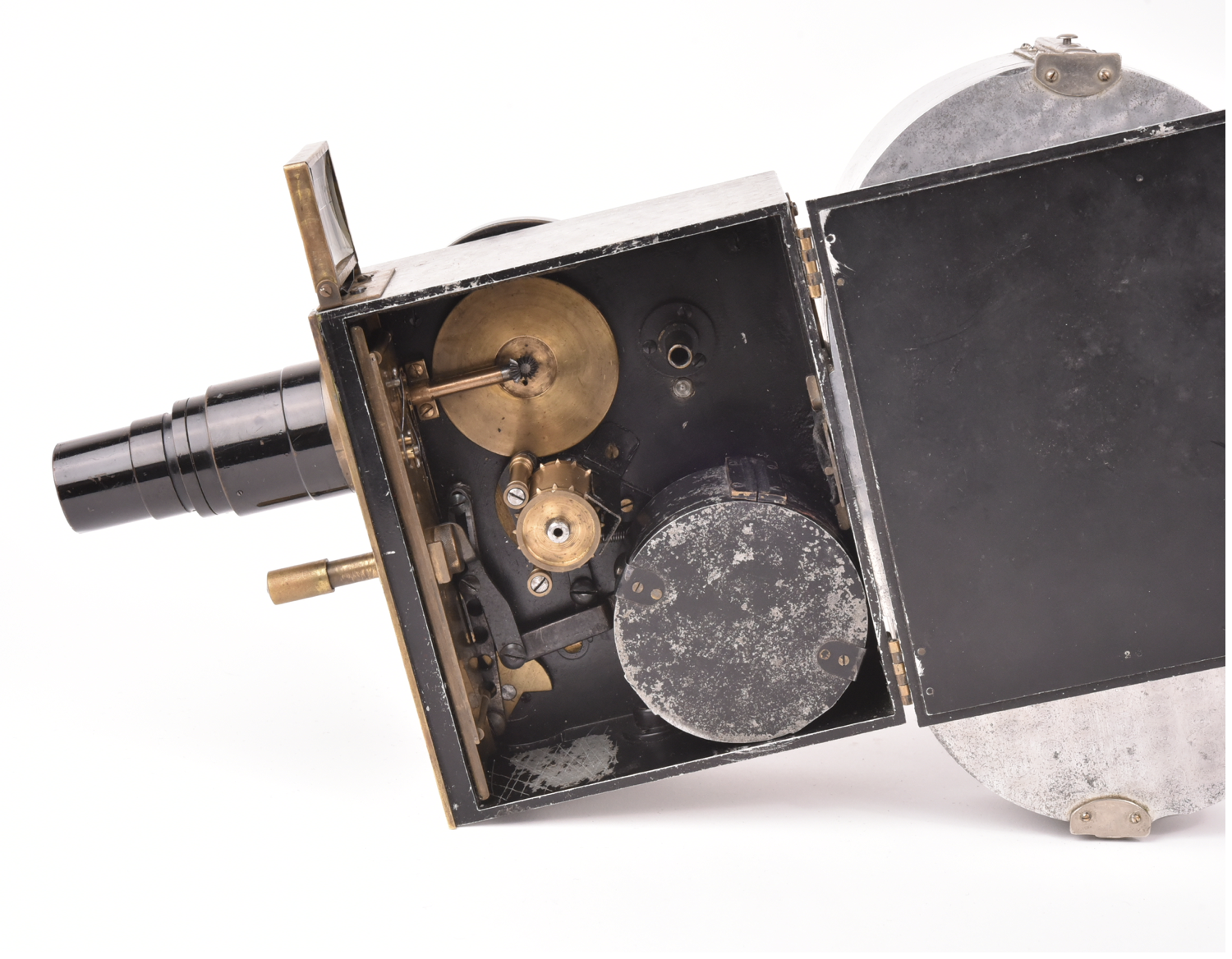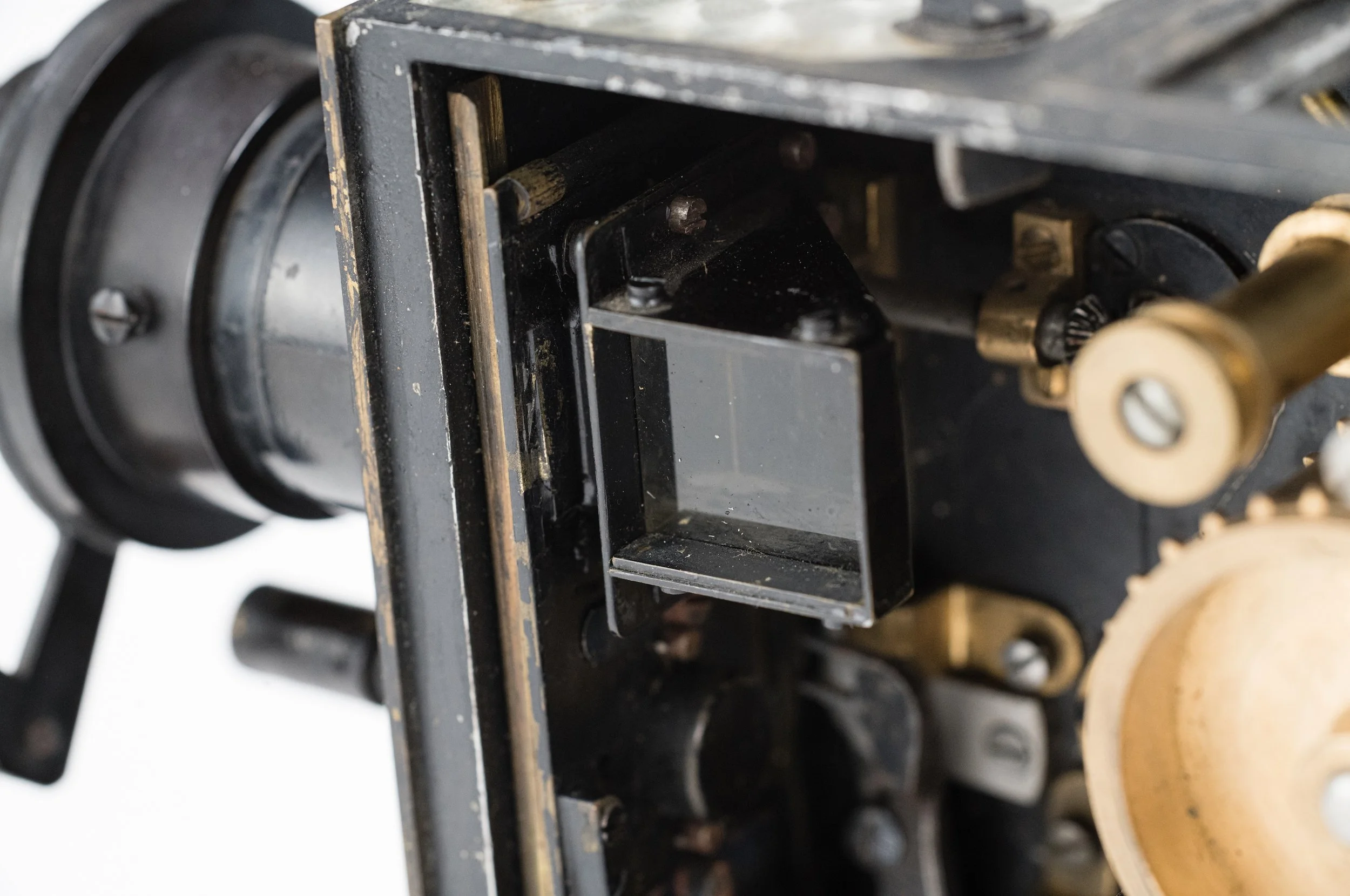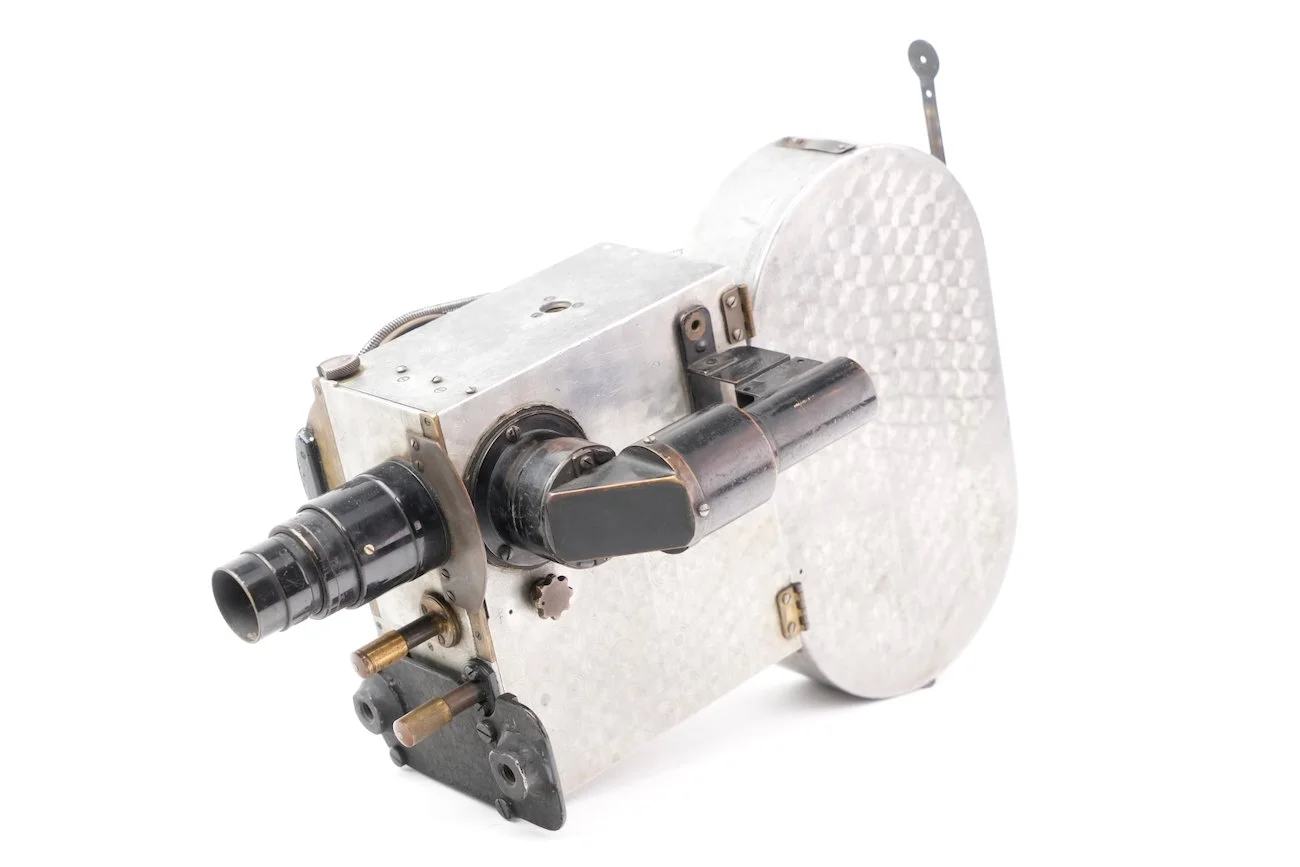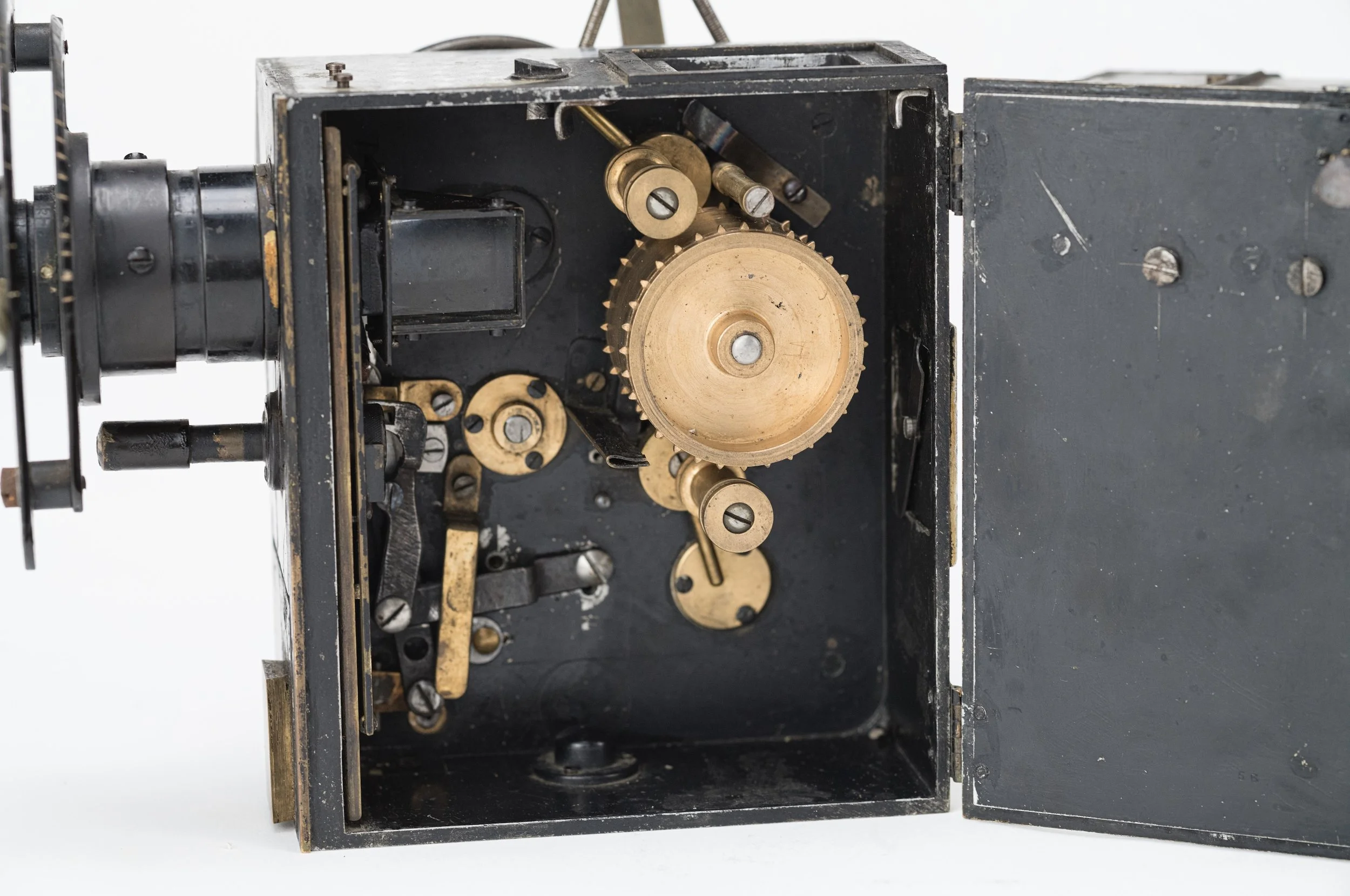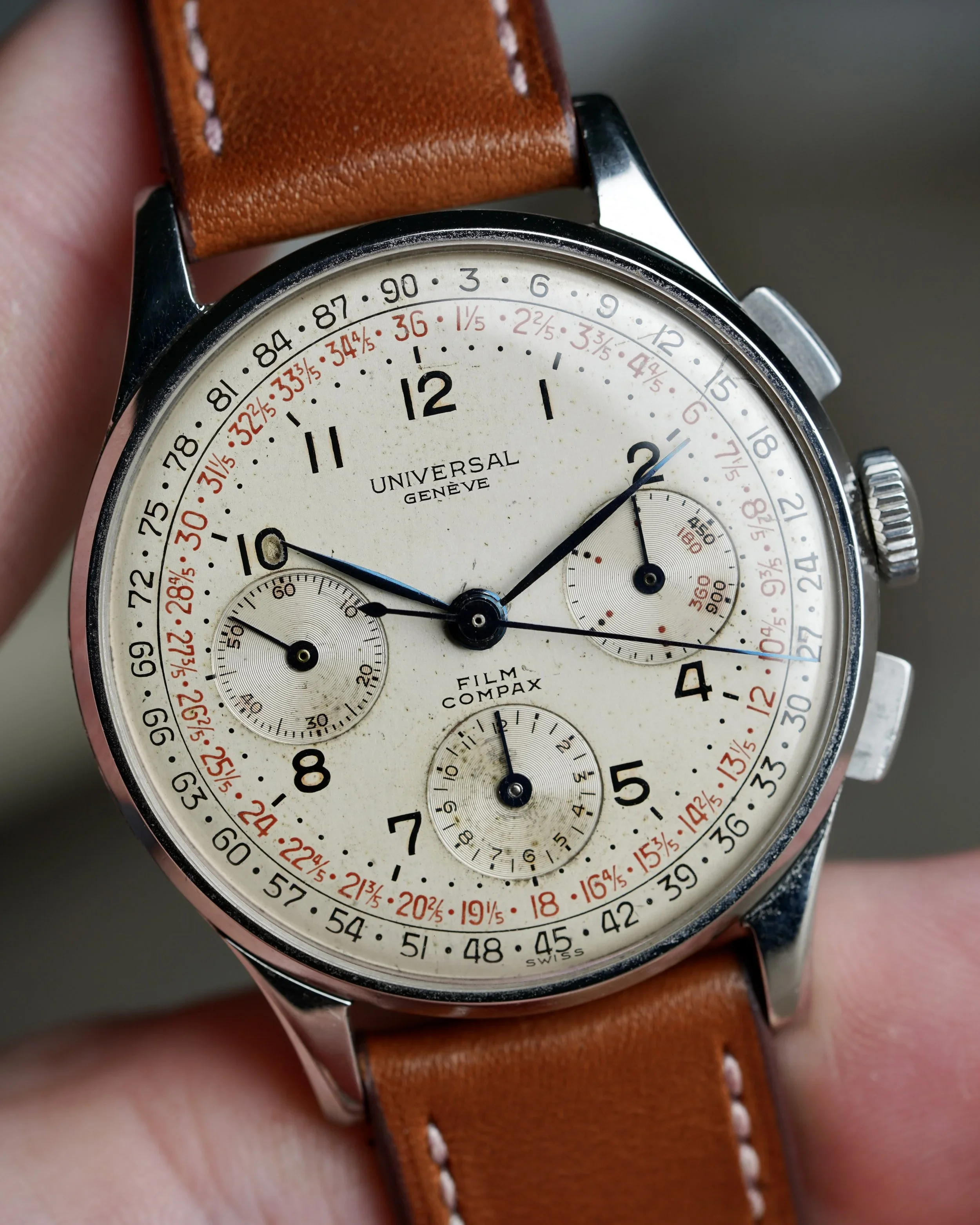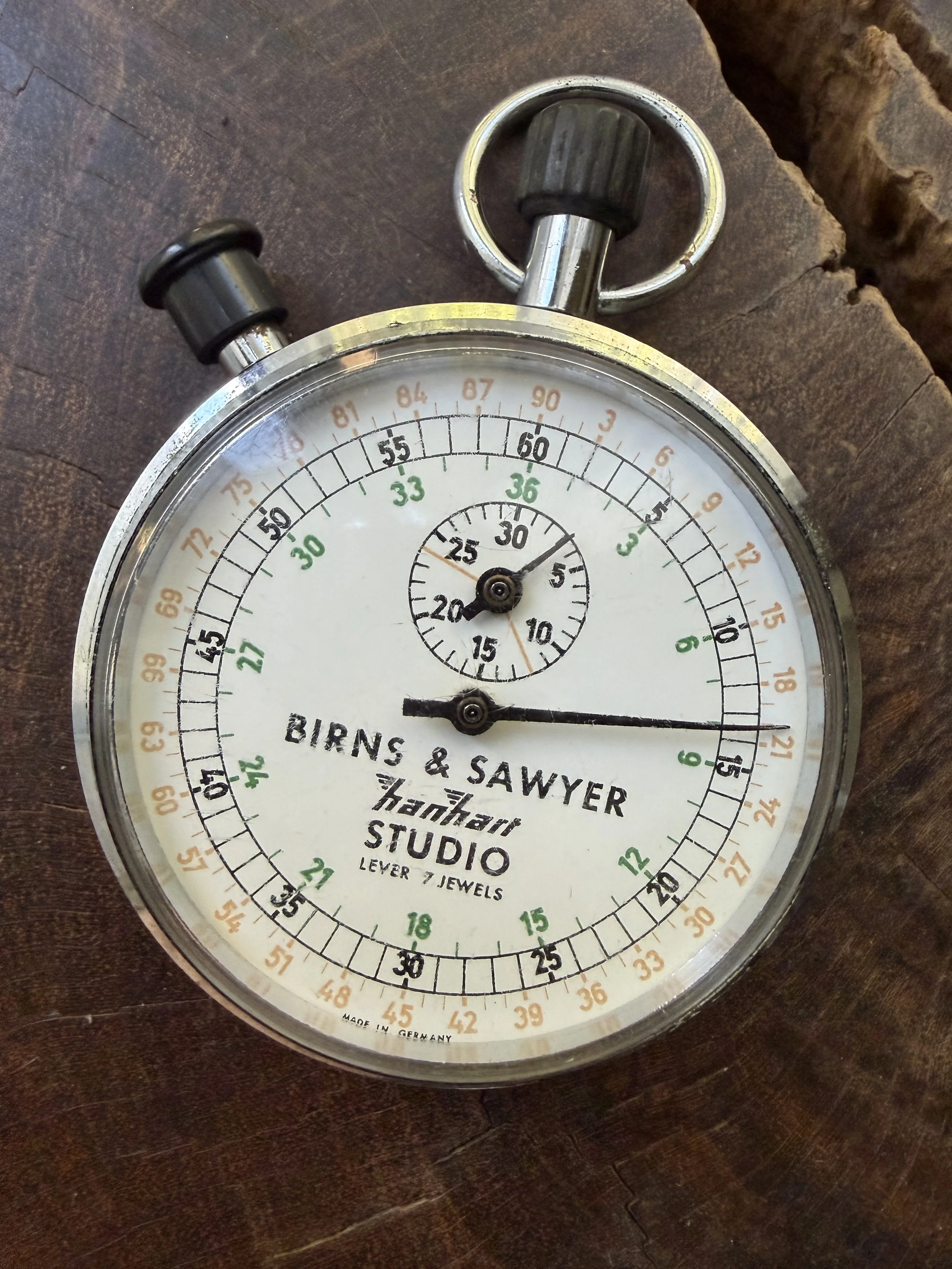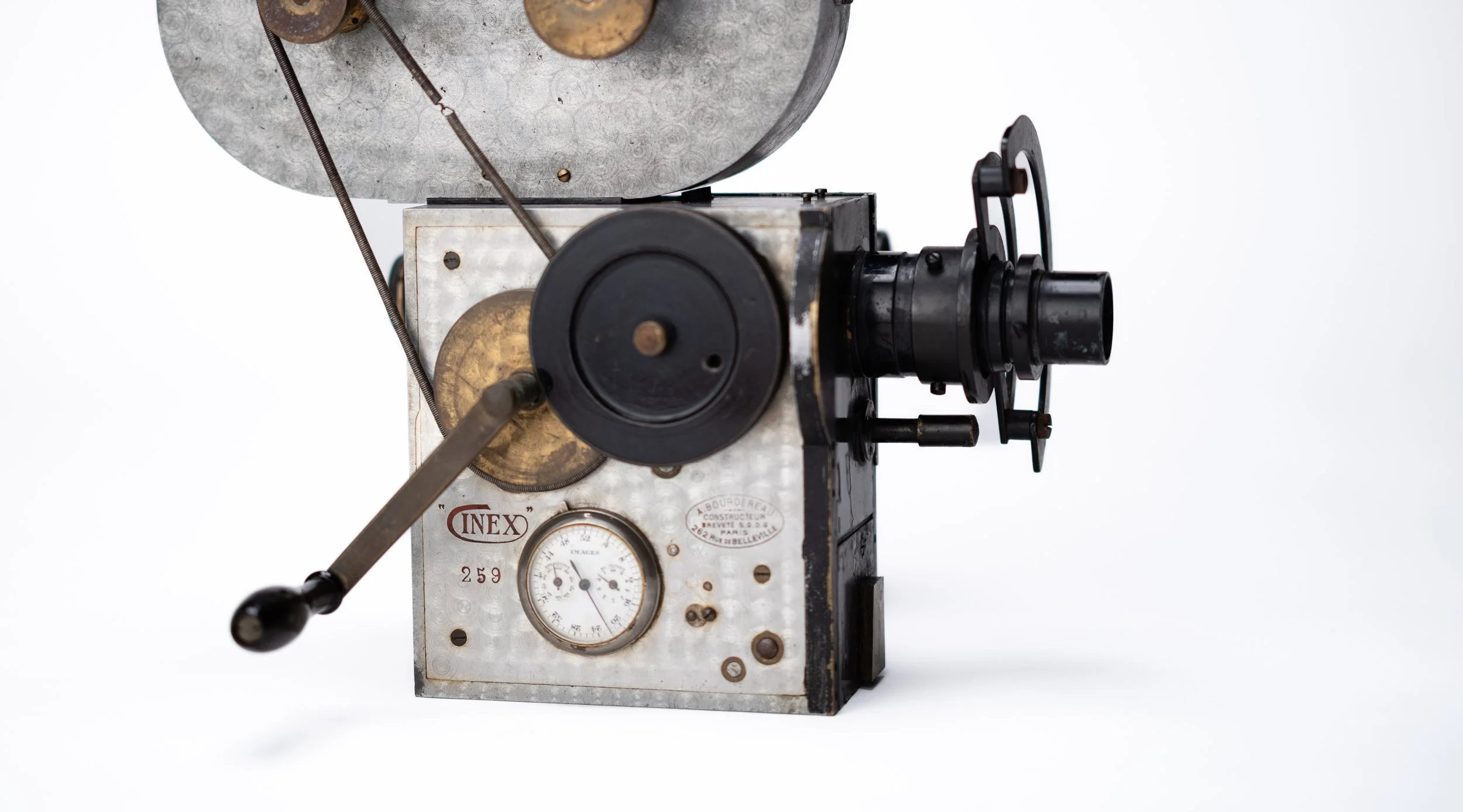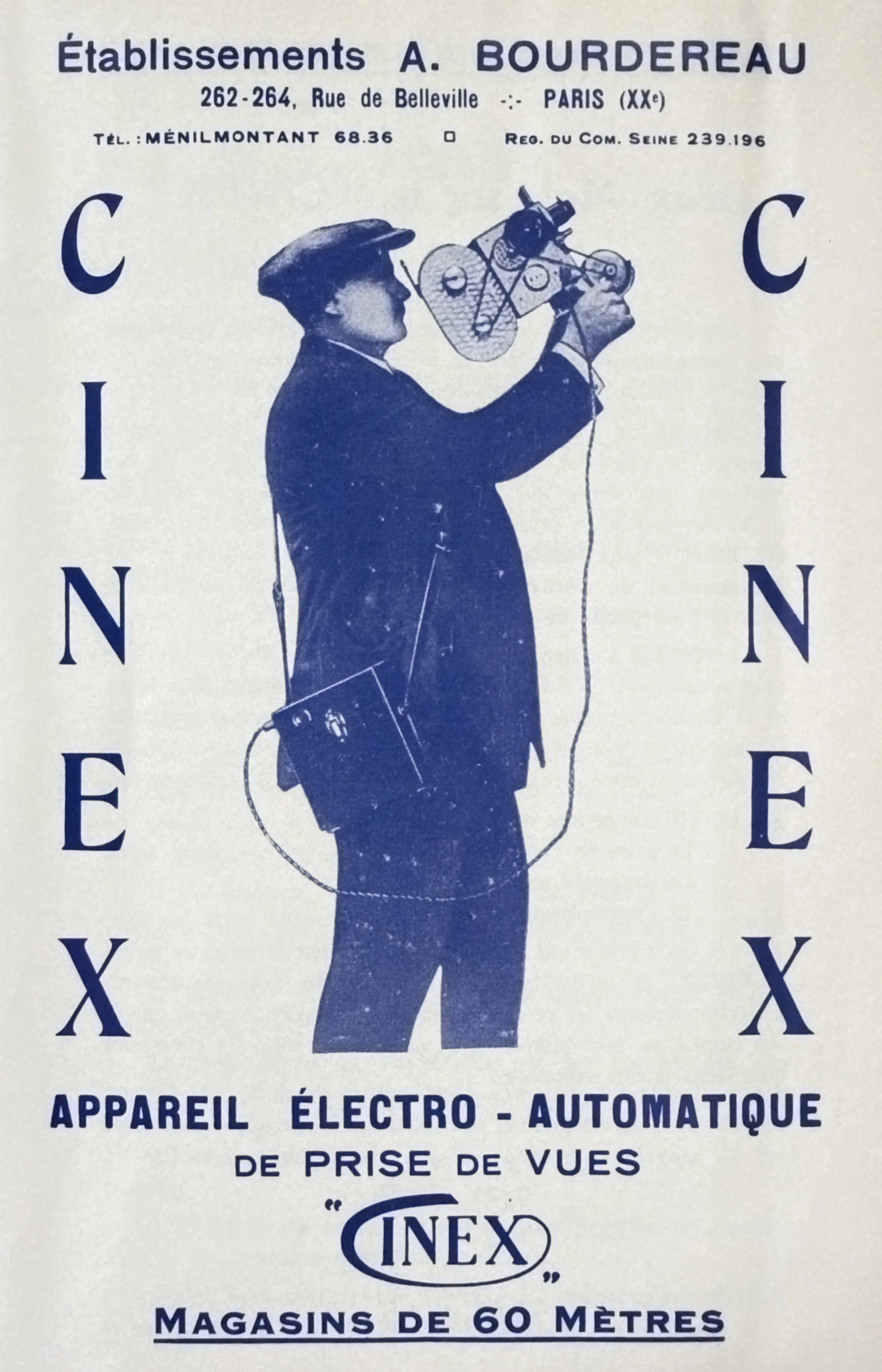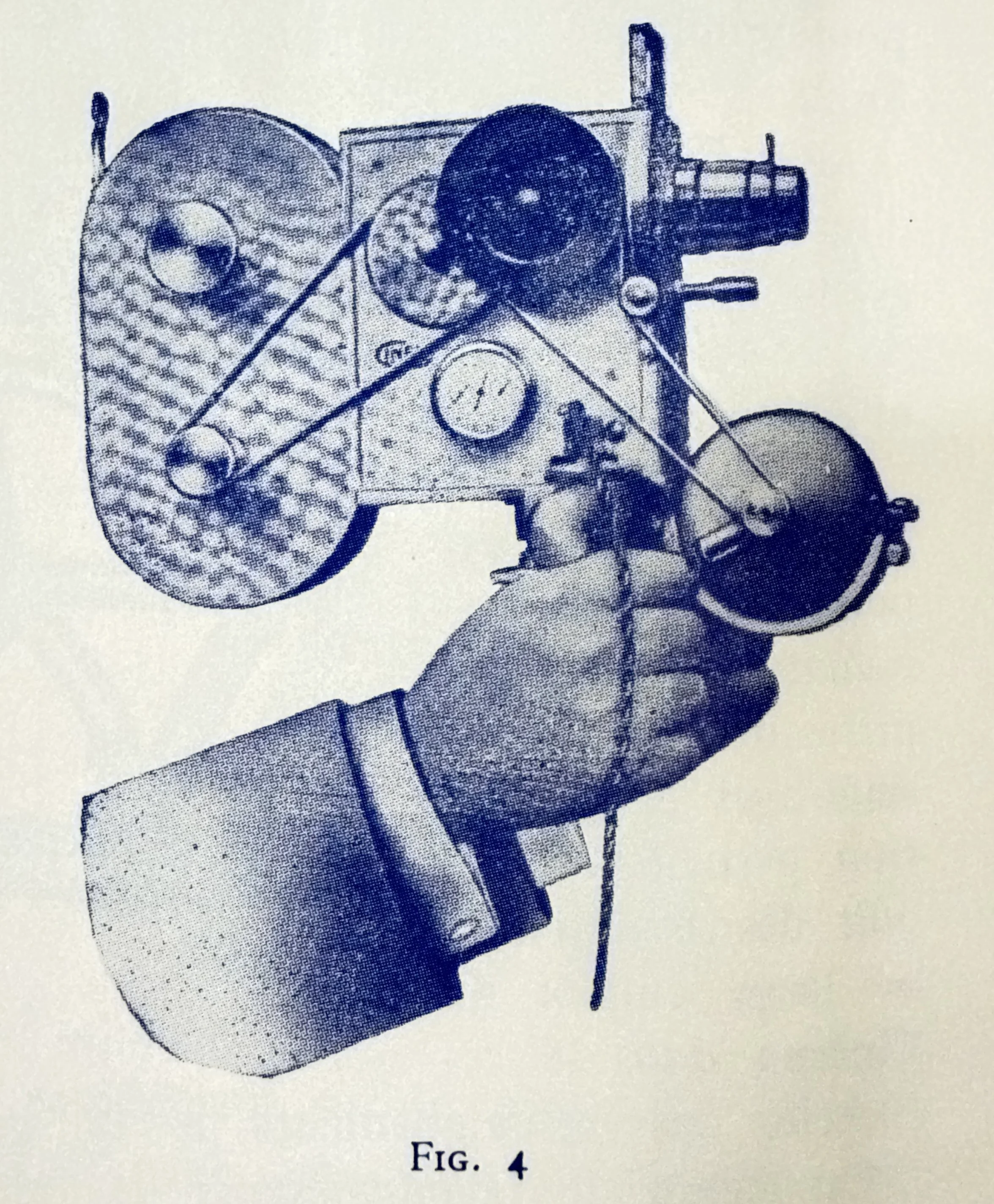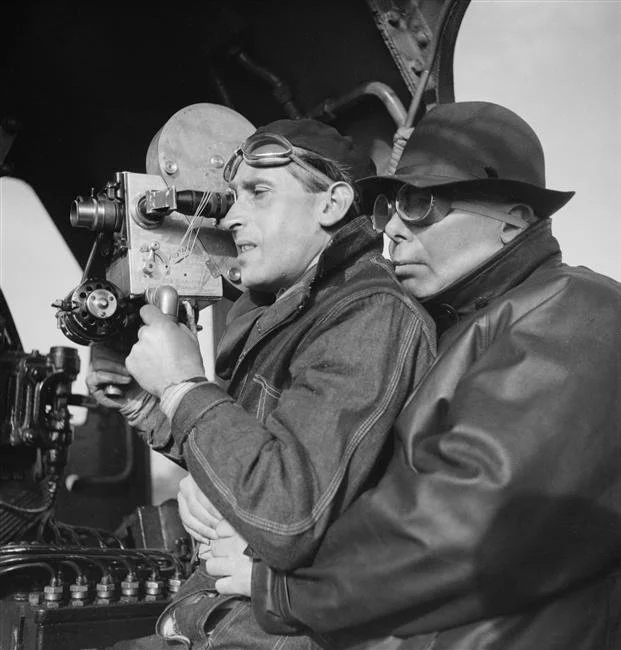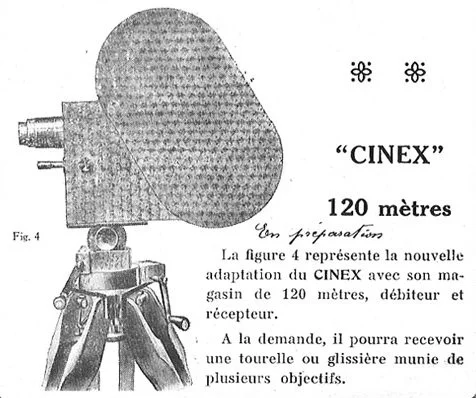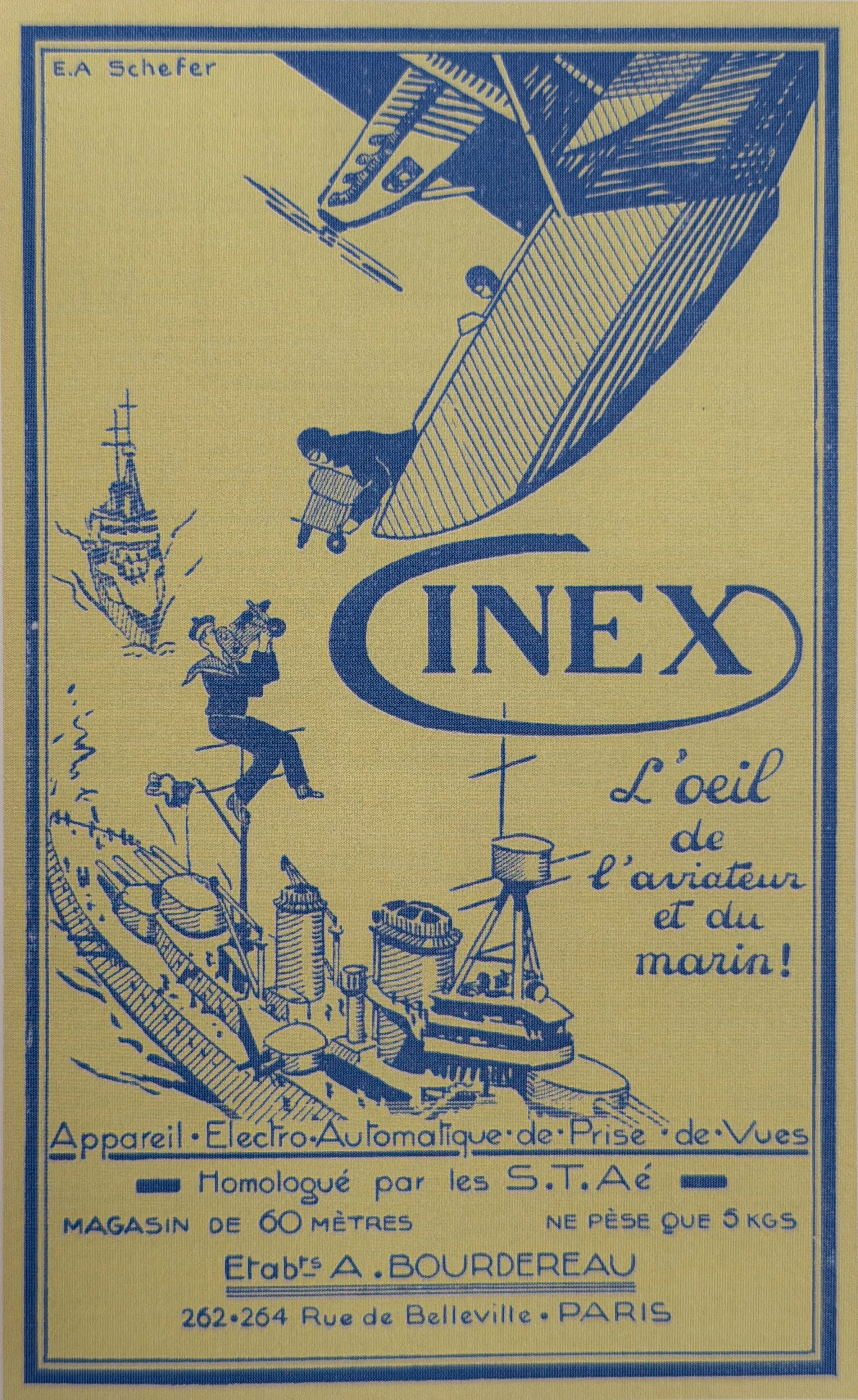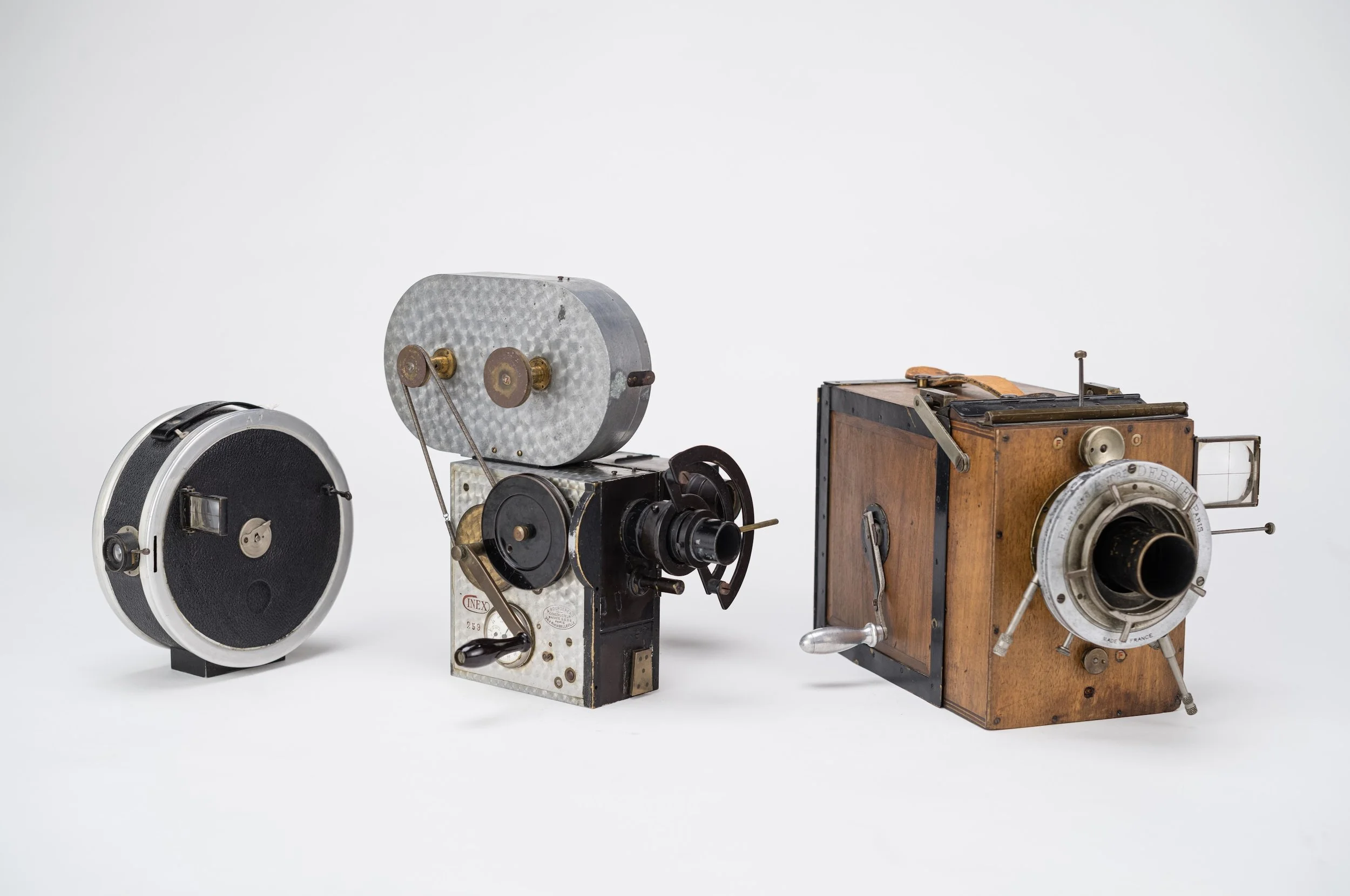Etablissements A. Bourdereau CINEX
Alphonse Bourdereau
Alphonse Bourdereau (1887-1962), a trained mechanic from Paris, France, began his career at Gaumont. In 1920, with several ideas in early development, Bourdereau partnered with financier René-Albert Piquois and started their own company, investing 50,000 francs to manufacture a developing machine and other film equipment. By 1922, after the team patented their first camera, Piquois left the company, and it became known simply as Etablissements A. Bourdereau.
Le CINEX
In 1922, Bourdereau introduced the first CINEX 35mm camera and moved his company to 262 Rue de Belleville in Paris. It was presented to the Société française de Photographie on December 13, 1922. The original CINEX was a beautifully engineered yet simple design. It featured two 20-meter internal magazines, a front-mounted film punch, simple flip-up optical sports finders, hand-crank operation, and a unique side-mounted chronograph-like footage counter. It was extremely compact, with external dimensions of 7 cm × 13 cm × 15 cm, and weighed only 2 kilograms. This first-generation CINEX had an all-black body. These early examples ended around serial No. 150.
Le Tout-Paris, Rue de Belleville in the 1920’s
“The CINEX is mounted with an extra-bright 3.5 mm, 50 mm focal length, helical mount lens. It can accommodate, at the operator’s discretion, any other focal length or any lens with a larger aperture, such as F2.5. Lenses of all brands, focal lengths, and apertures, including long focal lengths, can be adapted upon request.”
Le CINEX Advertising, 1923
CINEX No. 217- Collection of the French Cinematheque
CINEX - Improved Model
The following year, in 1923, Bourdereau developed and introduced an updated version of the CINEX 35mm motion picture camera, featuring a more versatile design. The new version was truly a work of art, beautifully constructed from cast aluminum. Bourdereau continuously refined the camera, with the first of the updated models entering production around serial No. 150.
Made entirely of decoratively polished aluminum with brass highlights, it now supported an optional external, rear-mounted magazine for 60-meter film loads. Bourdereau also modified the front with a new sliding dovetail plate that accommodated fast lens changes. The external dimensions remained the same—the 7 cm × 13 cm × 15 cm body was extremely compact—and it still weighed only 2 kilograms in its basic configuration.
CINEX No. 189 with both internal 20-meter and external 60-meter magazines.
A. Bourdereau produced fewer than 500 of the updated CINEX cameras. The earliest examples of the improved model retained the original internal 20-meter film magazines, in addition to an added door on the back of the camera to attach the new optional 60-meter external magazines. Starting around serial No. 225, Bourdereau completely eliminated the internal magazines in favor of only external magazines.
No. 259 with optional “virtual finder”, side finder and top mounted magazine
Later versions offered various updates and upgrades, including an optional top-mounted magazine, a 'virtual' viewfinder, a later modification to accommodate a larger 120-meter magazine, a turret, and even a side-finder.
CINEX No. 259
Additionally, the movement underwent various minor revisions, including several modifications to accommodate Bourdereau's virtual viewfinder, which appeared as an option starting around serial No. 259. The CINEX evolved with each unit produced, as Bourdereau constantly improved his design.
Virtual Viewfinder
“The CINEX is equipped with a hinged virtual viewfinder with eyecup. Focusing is achieved either by shifting the lens to project onto a ground glass screen that replaces the virtual viewfinder—thus preventing fogging of the film—or by using an erecting magnifier.”
CINEX described their innovation as a 'virtual viewfinder,' and while these early systems were not true reflex finders as we know them today, Bourdereau's first viewfinder was a pioneering step that would eventually lead to modern reflex viewing. The early virtual viewfinders were primarily tools for achieving critical focus rather than true through-the-lens viewing systems. However, as the design evolved through the late 1920s and into the 1930s, these systems began to approach what we would recognize as a reflex finder today.
Over a decade later, in 1937, Arriflex claimed to be first with the introduction of the Arri 35, promoting it as the first camera to allow a camera operator to focus through the viewfinder and frame the subject without any parallax errors—essentially claiming the title of first true reflex camera.
“A landmark year comes in 1937, with the design and construction of the first reflex mirror shutter camera, the ARRIFLEX 35. For the first time in moviemaking history, a camera operator can focus through the viewfinder and frame the subject without any parallax errors. This ability to actually see through the taking lens empowers filmmakers by giving them more control over their creative vision. ”
It had been attempted before. Carl Akeley tried to develop a reflex finder for his "Pancake" 35mm camera but was unsuccessful and ultimately settled on a dual lens system, with the viewing lens and taking lens mounted side by side for simultaneous viewing and shooting.
Who do you think developed the first reflex viewfinder for a motion picture camera? Leave your thoughts in the comments below.
Evolution of the CINEX virtual viewfinder
The new virtual finder made its debut around serial No. 259, though this early iteration lacked the 'hinge' feature described in later promotional materials. This hinge allowed the viewfinder to be rotated up or down to accommodate the operator's eye level.
By serial no. 356, the CINEX featured a more refined virtual finder, complete with the hinged mechanism and a locking system to hold the finder rigid in the center position. Later versions would refine this design even further.
CINEX No. 356 with a later style hinged viewfinder
Movement
“The CINEX has a double, adjustable shutter that allows it to achieve variable exposures. The unique feature of the shutter (unlike any other camera) is that it passes 3 mm from the film and achieves a flat focal length. No light loss, thus achieving 25% brightness over all existing cameras.”
The film movement employs a double claw actuated by an eccentric cam, which engages the film perforations on one side only. A double-feed drum equipped with two adjustable compression rollers maintains consistent film tension and loop control. The gate assembly is fully removable and utilizes spring loading to ensure uniform film registration and focal plane consistency. A cam mechanism integrated into the side door secures the gate in position.
“its mobile platform is a small mechanical masterpiece...the Cinex is a light instrument, but of high precision, robust and established by a first-rate mechanic.”
CINEX Footage Counter
A. Bourdereau’s CINEX 35mm camera and its unique Footage Counter
One of the CINEX's most distinctive features is the chronograph-style footage counter mounted on the side of the body. The elegant mechanism is reminiscent of fine watch chronographs, with a dial containing three complications: the primary register measures individual frames, the right subdial tracks increments of 10 meters, and the left subdial counts increments of 100 meters. A reset lever sits at the top. As a tool watch collector, this feature was what first drew me to the CINEX.
Twenty-three years later, Universal Genève introduced the ref. 22522 Film Compax chronograph with a similar film meter function. Designed for the American film industry, it featured specialized complications to track film consumption. Dual-colored scales—red for 16mm and black for 35mm film—measured footage in feet per second, both calibrated to the industry standard of 24 frames per second. The three o'clock subdial included additional markings for measuring film usage beyond the first minute. This example is from Eric Wind's collection.
It would be another decade before American rental house Birns & Sawyer offered a similar German-made stopwatch called the "Studio" in their catalog with the same functionality. The Studio Stopwatch was sold in their catalog well into the 1980’s.
Cinex Advertising, 1925
The "CINEX" Electro-Automatic Camera
Beginning in 1925, Bourdereau added optional handles and a motor with a switch on the right handle for full control. The CINEX is one of the first cine camera designed specifically for handheld work, and with this new option it was considered by many to be the best available hand held camera in the world, especially when combined with the new “virtual” finder for focusing and framing the camera.
CINEX Electro-Automatic No. 294, Collection of the French Cinematheque
Weighing only five kilograms fully rigged, its automatic operation made it easy to film fast movements or to place the camera in cars, planes, or on the ground. It was an ideal hand held camera and became very popular with both professionals and amateurs.
The "Cinex" Electro-Automatic Camera.
“The CINEX is of impeccable construction, simple, and robust; the subject of extensive research, it delivers perfect results and is so simple to operate that it can be used by even the most inexperienced.”
CINEX 120 mètres
Cinematographer Curt Courant and Director Jean Renoir shooting La Bête humaine.
This CINEX was yet another factory modification in 1927 with the rear body cut away to enable a larger 120m magazine to be mounted at an angle to the body, very similar to the much later Arri 235 design. The Cinex 120 Meters was a custom order modification. It was one of the most compact cameras used in France. Many productions adopted this apparatus for difficult set-ups, including Leon Poirier's La Croisière noire (1926), shot in the harsh conditions of the Sahara Desert, and Curt Courant's highly realistic train scenes in La Bête humaine.
CINEX 120 mètres
Figure 4 shows the new CINEX adaptation with its 120-meter magazine, feeder, and receiver.
Upon request, it can accommodate a turret or slide equipped with multiple objectives.
“But when it came to filming equipment, the Cinex camera was a revolution.
Developed by the Bourdereau company in 1922, this camera, in its electro-automatic version—which also allowed projection, printing, and enlarging—became the benchmark in aerial cinematography by the mid-1920s. The STAé approved this device, which became a marketing tool for its manufacturer. Indeed, its use in military and naval aviation gave rise to the slogan: ‘The eye of the aviator and the sailor’.”
Cinex. The Eye of the Aviator and the Sailor, La Revue maritime, new series, No. 89, May 1927. BNF Collection
"CINEX" device approved by the Aeronautical Technical Services
When it was first introduced, the Cinex was the smallest 35mm motion picture camera in the world. Its compact size quickly caught the attention of pilots, and the French Air Force became interested in equipping its aircraft with Bourdereau's camera.
The French Air Force adopted the Cinex to film training exercises and reconnaissance missions. Cinematographers and newsreel photographers soon discovered the camera's adaptability for fast action and aerial work.
CINEX Aeronautical Mount
The "CINEX" (fig. 6), equipped with a long-focus lens, was specially designed for vertical and oblique aerial shots.
Working with French Air Force Captain Germain Petitot, an engineering officer assigned to aerial reconnaissance, Bourdereau developed a shock-absorbing mount system for aerial photography. Around the same time, they added a remote handle, and the camera became known as the Electro-Automatic Camera. This was likely one of the earliest uses of a remote handle on a motion picture camera, a feature that has since become standard on all cinema cameras. Petitot also played a key role in publicizing the aeronautical applications of the Cinex and became widely recognized as the military's leading cinema specialist for aviation.
Bulletin of the French Photographic Society.
Lieutenant PETITOT presented, on behalf of the BOURDEREAU ESTABLISHMENTS, a panoramic platform with shock absorbers intended for shooting with a Cinex camera. This platform is mounted on the standard machine gun mounts… which he illustrated with a film taken with the above-mentioned cameras.
“A reconnaissance and intelligence aircraft flying over an area where troop movements, convoys, railways, etc., are taking place, equipped with a “CINEX” camera, has the power to record all these movements at very high altitudes without attracting attention. A good shot taken under these conditions allows for the projection of highly interesting information. ”
WWI Ace Marcel Doret worked with Bourdereau on a modified rig to film his stunt work and test flights. Mounting the camera on the rear of his fuselage, Marcel shot cinematic films of his acrobatic flights creating a first person view of his stunts.
Doret's footage was also used in the 1927 film Le duel and the 1937 film Le ciel est à elles. While the Cinex was proving itself in French skies, across the Atlantic another camera was establishing an even larger reputation for aerial cinematography. The Akeley Pancake became the dominant choice for American aerial work, most notably in the production of Wings (1927), which won the first-ever Academy Award for Best Picture. The film's groundbreaking aerial sequences required extensive camera resources—over 200 cameras were used during production, with many of those being Akeley Pancakes specifically chosen for their ability to capture high-speed aerial action. Cinematographers like Elmer G. Dyer, ASC and Faxon Dean, ASC relied on the Akeley's innovative gyro head and compact design to film the realistic dogfight sequences that made Wings a landmark achievement in cinema. Learn more about the Akeley Camera and its impact on early aerial cinematography in our dedicated blog post.
Marcel Doret, 1926
“The CINEX is nothing like the cumbersome ordinary camera; nor is it like those tiny cinematographic toys, certainly not without merits, but insufficient, incomplete, and not very suitable for giving us a true idea of this mysterious and captivating art that is Cinematography. ”
CINEX no. 259
This early CINEX example from my collection is serial No. 259, and it features several optional upgrades along with some unique factory modifications. The film magazine was relocated from the rear to the top of the body—a change that required corresponding modifications to the movement. The main sprocket was enlarged and repositioned rearward to accommodate the top-loading film path.
Where earlier CINEX cameras relied on simple flip-up "sports" finders for framing, this example features an early iteration of Bourdereau's new "virtual viewfinder," which allowed cinematographers to view directly through the lens for focus.
No. 259 marks the first documented appearance of this new virtual viewfinder system. This early version was mounted directly to the side panel and lacked the hinged mechanism that would become standard on later iterations.
Additionally, no. 259 features a custom-mounted Pathé-style side finder. The lens was modified specifically for use with this finder, allowing the operator to read large focus and iris scales from behind the camera—a significant ergonomic advantage. The front lens board was painted black to minimize reflections, a practical detail for challenging shooting conditions.
This isn't a standard configuration. In fact, it's the only CINEX I've encountered with this setup. Everything about it suggests a highly specialized, purpose-built design. My best guess? It was custom-ordered for aerial cinematography. Let me know your thoughts in the comments below.
No. 259 spent part of its working life in Japan, where a previous collector discovered it. The camera package includes a set of filters and a homemade silk diffusion set, all marked T. Fujita, offering a glimpse into the camera's journey and the cinematographer who once worked with it.
A few of the options available to cinematographers in the mid-1920s: the Arri Kinarri, A. Bourdereau's CINEX, and André Debrie's Le Parvo line.
REFERENCES:
Le Courrier Cinématographique n° 8, [1923]
Notice publicitaire Le "Cinex" appareil cinématographique Bté S.G.D.G. de prise de vues et projections, tirages et agrandissements, Paris, Bourdereau, s.d. [1923]
Appareil électro-automatique de prise de vues Cinex, Paris, Etablissements A. Bourdereau, s.d. [1923]
Bulletin of the French Photographic Society. Sixty-Seventh Year, Third Series. Volume XII [1925]
The King of Aerial Acrobatics Marcel Doret. Cinematic Synchronism –Aerial Prowesses, La Cinématographie française, No. 398, Lucie Derain [1926]
The Cinematic Mail No. 53, [1927]
Tout Cinéma, [1927]
Le Cinématographe scientifique et industriel, Jacques Ducom, Paris, [1931]
Histoire de la Camera Amateur, Michel Auer, Michele Ory [1979]
Ariel Cinematographica Register no. 590, Peter Ariel [1981]
"Die Bourdereau Cinex 35", Camera Magazin n° 8, Gerhard Fromm [2002]
Motion Picture Photography: A History, 1891-1960, H. Mario Raimondo-Souto [2014]
Les Fondamentaux, n° 82, Alphonse Bourdereau, Etienne Gérard [2022]

